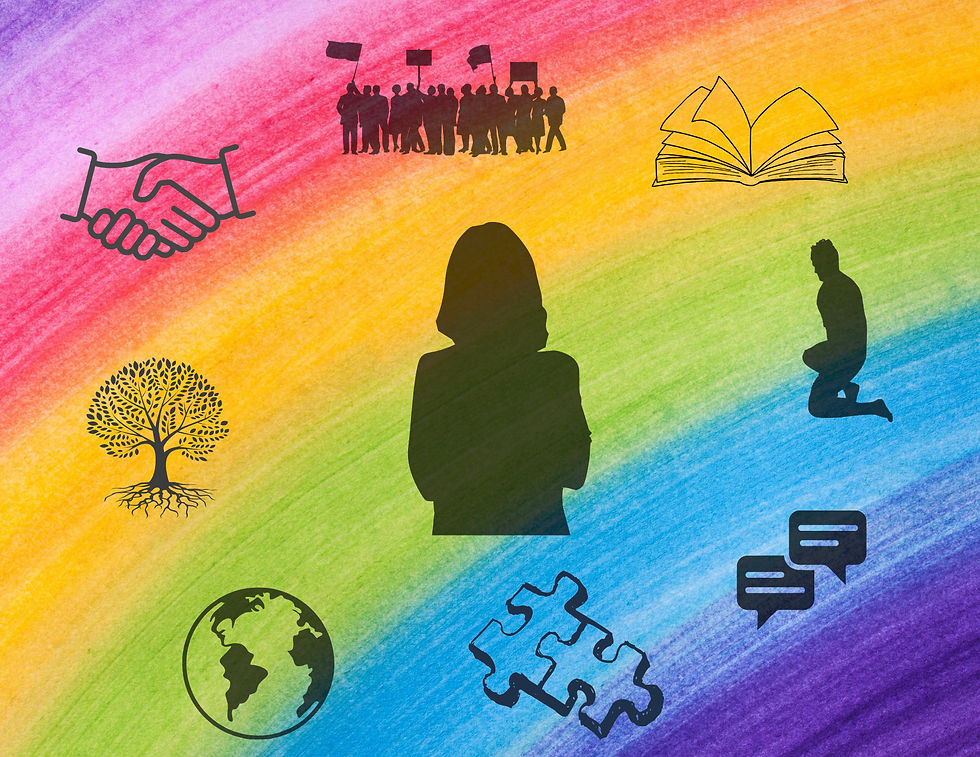Helping Teens Thrive in a Pluralistic World: Intercultural Skills for Real Life
- sarahwoltersco
- Jun 2
- 4 min read
Updated: Jul 17
This post builds on my recent workshop for educators on developing intercultural competence in high school students. Whether you attended or are diving in fresh, these reflections are meant to help you take practical next steps in your own learning or leadership.
In today’s world, young people are growing up surrounded by a wide range of cultures, perspectives, and experiences. That may have always been the case, but now young people are living in a society that is comfortable vocalizing those differences. Gone are the days of “we don’t talk politics” - and that goes for elementary school on up. Whether in school, online, or in their communities, teens are constantly navigating a world where many truths exist loudly side by side. This is the essence of plurality - the idea that no single perspective holds the whole story, and that there is value in engaging across differences.
That’s where intercultural competence comes in. It’s not a checklist or a political statement. It’s a soft skill that helps teens lead with empathy, communicate across cultures, and solve problems in diverse settings. While tools like the Intercultural Development Inventory (IDI) can support this growth, the focus here is on building intention and understanding that help teens thrive in a pluralistic world.
1. Why Intercultural Competence Matters for Teens in a Pluralistic

World
Intercultural competence helps teens better understand their own perspectives while learning how to connect with people who see the world differently. It matters because teens today:
Collaborate in diverse classrooms and group projects.
Participate in clubs, sports, and online communities with a variety of cultural norms.
Will eventually work in global and multicultural environments.
When teens understand plurality - that multiple cultural values and lived experiences can coexist - they become more adaptable, respectful, and thoughtful in how they engage with others.
2. Making Intercultural Growth Accessible and Meaningful
Teens are most engaged when learning feels real. Intercultural learning should reflect their daily lives and challenges. Here’s how:
Use age-appropriate language when discussing cultural awareness.
Connect learning to teen experiences: friendships, social media, classroom discussions.
Encourage questions and reflections rather than providing "right answers."
Classroom-ready approaches like journaling, story circles, and cultural role-playing can bring these conversations to life.
3. Getting Ready to Grow: Mindsets for Intercultural Learning
Before diving into any formal assessments or activities, it’s important to set the stage. Let teens know:
This journey isn’t about being perfect. It’s about being open.
Everyone has a cultural perspective - and we can all grow in how we see others.
Plurality means we might not always agree, but we can always choose curiosity over judgment.
Honesty matters. Self-awareness only grows when we’re real about our starting point.
4. What This Isn’t
Intercultural competence isn’t about having all the answers - or forcing agreement. It’s not a political performance. It’s about growing the soft skills to stay grounded, listen well, and respond with intention in moments of tension or misunderstanding.
5. Leading with Plurality: What Inclusive Youth Leaders Do
Teens in leadership roles can model intercultural competence in powerful ways. When

leaders understand plurality, they:
Create space for different voices often leading to stronger and quicker solutions.
Resolve misunderstandings with empathy.
Make decisions that reflect the values and needs of a diverse group.
Example: In student government, a leader might notice certain students never attend events and choose to ask why, learning that the events clash with cultural or religious obligations. That’s intercultural leadership in action.
6. Real-Life Applications for Teens
When teens build intercultural skills, they lead clubs more equitably. They speak up when someone is excluded. They bring cultural awareness into how they design projects, write papers, or even moderate group chats. They’re better teammates, stronger leaders, and more thoughtful friends.
7. Common Challenges and How to Support Growth
Learning to engage across differences isn’t always easy. Teens may:
Feel defensive when asked to reflect on bias.
Avoid cultural conversations out of fear of saying the wrong thing.
Tips for success:
Normalize discomfort: growth feels awkward.
Use real-life stories to ground learning.
Celebrate effort and small wins.
Focus on progress, not perfection.
Intercultural growth doesn’t start with curriculum - it starts with us. Teens are attuned to whether adults model curiosity, admit what they don’t know, and show respect for diverse viewpoints. Whether you’re asking a better question, adjusting a deadline for inclusivity, or naming a bias in yourself, small moments model plurality in action.
Building intercultural competence prepares teens for the world they’re already living in: one filled with multiple perspectives, cultures, and values. In a pluralistic society, the ability to navigate differences with empathy and openness is not just a leadership skill - it’s a life skill.
As an educational consultant, DEI consultant, and leadership consultant, I’ve seen how impactful it is when schools, youth programs, and community organizations take intentional steps to foster these skills in young people. Whether you're leading a classroom, mentoring teens, designing youth programs or thinking about this as a parent, you can play a powerful role in preparing the next generation to lead with curiosity, empathy, and intercultural awareness.
Developing Intercultural Competence through Youth Development
Wondering if your organization is ready to take the next step? Start with the IDI Readiness Assessment to see how prepared your team is to implement intercultural development practices. It’s a quick, reflective tool to help you take the first step toward deeper impact.
Let’s work together to help our youth thrive in a pluralistic world.




Comments